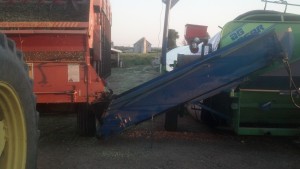– Stan Smith, OSU Extension PA, Fairfield County
Here’s my thought for the day: The drought is so extreme in parts of Ohio that we may have more high quality feed available to feed cows and background calves than ever before! Yes, you read that correctly . . . the result of this drought may ultimately provide for us more feed for some classes of ruminants than we might have available in a typical year. Let me explain.
About a week and a half ago corn silage harvest began locally. This corn was planted early, didn’t get very tall, and was quickly drying up from the heat and lack of precipitation. Like much of the corn belt, since May 1, the county is about 7 inches below normal on precipitation.
Here’s the bottom line . . . that corn yielded 16 tons of corn silage per acre at about 39% dry matter. Not bad until you discover there was little grain in it. The crop insurance adjuster estimated the grain yield at 22 bushels per acre.
Depending on what day you sell it, that 22 bushels of corn might result a gross income of $200 per acre in value. Can we realize more value than that from 16 tons per acre of corn silage if it’s fed to brood cows, or feeders calves which have weakened in price over recent weeks?
Perhaps it’s not the way we’ve fed cows – or backgrounded early weaned calves – in the past, but fact is, even the corn silage described above would likely be, by far, the highest quality feed a majority of Ohio’s brood cow herd has ever seen. And, the quality of corn described above is abundant throughout Ohio this year.
No silo – no problem. Many Ohio dairymen and cattlemen, and a few shepherds have harvested and bagged silage successfully for years. Hiring it done on a totally custom basis would likely cost in the neighborhood of $10 to perhaps $15 per ton, as bagged. If you value that 16 tons of corn silage at the $200 per acre the 22 bushels of grain would have generated, and add custom harvest and bagging costs, when you get through all the math you have 61% moisture feed at a cost of ~ $25 per ton. That equates to less than $70 per ton of dry matter. How much high quality hay can be found today at that value?
If you want more detail on making or valuing silage from drought stricken corn, visit our “Drought Management” pages linked at http://beef.osu.edu . Fact is, due to a quirk of fate, we may have more high quality, affordable feed available for Ohio’s cattle herd this year than ever before. Admittedly logistics may be a challenge in some parts of the state, but I suspect creative minds can figure that one out. Is it time to add cows, or purchase light feeders?
As you consider the alternatives, keep in mind that those who are pro-active in their planning, and creative in adapting those plans to current as well as foreseeable conditions will likely be rewarded for years to come.

